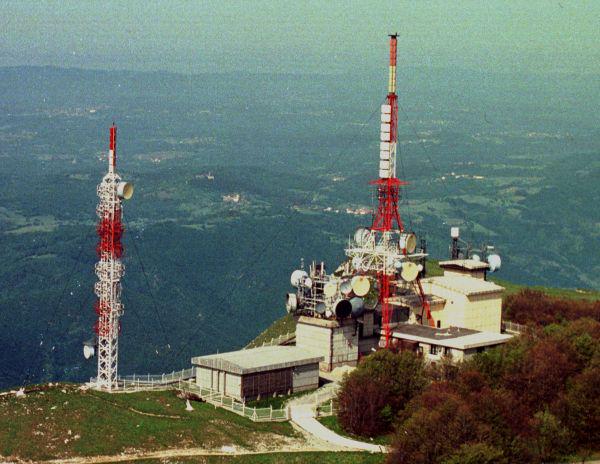
Nanos, a mountain in southwestern Slovenia, is prominent sight on the road between Ljubljana and the Slovenian coast. For many travelers heading south, it marks the beginning of the Mediterranean and one of the last glimpses of Central Europe. The top of the mountain is also the site of a powerful television transmitter - a prominent structure that has changed the face of broadcasting in both Slovenia and Italy.
Its beginnings were relatively inauspicious; in 1955, a small FM transmitter was launched on Nanos. Two years later, a TV transmitter was added; it was designed to replay a mix of Yugoslav and Italian programming to viewers in southwestern Slovenia. In December 1962, a large, state-of the art transmitter began operations; from then on, it has been manned by a full-time crew who spend three-week shifts living in the facility.
In 1969, the Nanos transmitter suffered an unusual disaster. The mountain was long known for its hurricane-force winds known as "bora", but even by those standards, the gusts recorded on February 4 of that year were extreme. When the winds reached their peak, technicians heard a crashing sound. They went out into the night to inspect the damage and noticed that the mast was no longer there: It had been toppled by a strong gust.
At the time, the transmitter wasn't even equipped with telephones, so the technicians had to contact other transmitters via a two-way link in order to tell the outside world what had happened. At first, their report was dismissed as a hoax; it turned out that just a few weeks earlier, the same technicians had filed a false UFO sighting as a prank. To set up a backup transmitter in the wintry conditions, crews had to bring replacement equipment from the valley on a sled.
The transmitter was soon repaired, and just a short time later, it made broadcasting history. It began to transmit Italian-language programming from a small station in the coastal Slovenian town of Koper. Because of its height, its signal was able to cover much of northeastern Italy, and smaller repeater station extended the channel's reach well into the Apennine Peninsula. For many Italians, the new popular station provided a choice of programming for the first time. Even more importantly, it was the first broadcaster to transmit in color. Because it used the German PAL color system, many Italian viewers chose to purchase PAL television sets, dashing the hopes of the French who had hoped to persuade the Italians to adopt their SECAM standard instead.
In 1991, the Nanos transmitter found itself on the front pages once again. During Slovenia's ten-day War of Independence, it was bombed by the Yugoslav Army. It sustained major damage, but no one was injured and the committed crew managed to restore TV signal within days.
Today, the Nanos transmitter broadcasts a number of digital stations; it also houses a small museum in which visitors can explore old, analog-era equipment and learn about the facility that ushered in the television era in this part of Slovenia - and strengthened the cultural bonds between Slovenia and Italy in the process.

































































